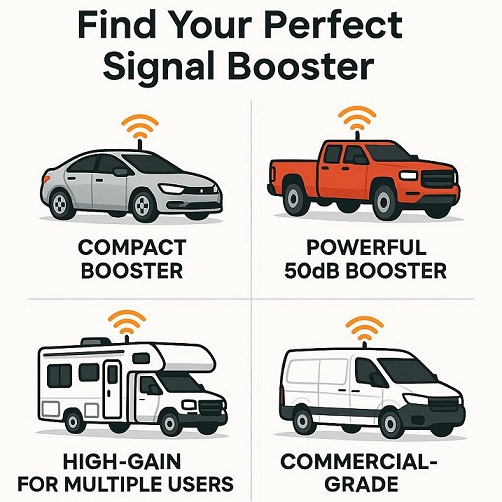Stay connected on the road — even in dead zones, remote highways, and rural travel routes.
Introduction
Modern drivers depend on strong mobile reception more than ever. Whether you’re navigating through GPS, streaming music, calling family, running a business from the road, or driving commercially across multiple states, reliable cellular connectivity is essential. But the reality is that signals weaken quickly once you leave dense city areas. A vehicle cell phone signal booster is the definitive solution to this problem, amplifying weak signals in dead zones, remote highways, and rural travel routes.
Weak cellular coverage results in:
Dropped or failed calls
Sluggish mobile data speeds
Frozen GPS navigation
Inability to communicate during emergencies
Poor business connectivity for truckers and RV travelers
This is where vehicle cell phone signal boosters come in. They amplify weak outdoor cellular signals and rebroadcast them inside your vehicle, improving both call quality and data performance for multiple devices simultaneously.
In this detailed guide, you’ll learn:
Why vehicle signal behaves differently from home signal
How vehicle signal boosters work
Different kinds of boosters for cars, trucks, RVs, and fleets
How to choose the right booster
Installation basics
Best models for rural areas and highways
When boosters cannot help
Tools and resources to diagnose and improve your signal further
Why Your Vehicle Needs a Cell Phone Signal Booster
Vehicle connectivity challenges are unique compared to indoor environments. While home boosters improve reception across rooms and floors, vehicles face constant movement and changing network conditions.
Key reasons mobile signals weaken inside vehicles:
| Cause | Explanation |
|---|---|
| Metal vehicle body | Blocks radio frequencies, drastically reducing indoor signal ability. |
| Tinted or UV-coated glass | Reflects RF waves, preventing signal entry into the vehicle cabin. |
| Distance from cell towers | Highways and deserts have fewer towers than cities, causing weaker signal strength. |
| Terrain obstacles | Trees, hills, bridges, and tunnels create natural signal blockage and attenuation. |
| Carrier congestion | High-traffic routes saturate tower capacity, resulting in slow data and dropped calls. |
| Network transitions | Switching between LTE, 5G, and 3G networks can cause temporary loss or instability. |
Even if your phone shows full bars outside, you may see only 1–2 bars inside your vehicle due to RF shielding.
Resulting performance issues
Call drops especially around turns or valleys
Slow or unusable data in remote regions
GPS recalculation delays
Poor hotspot performance
A good vehicle signal booster solves these problems by capturing outside signal through an external antenna and rebroadcasting a stronger signal indoors.
How a Vehicle Cell Signal Boosters Work
Vehicle boosters are FCC-approved devices consisting of three main components:
| Component | Function |
|---|---|
| Outside antenna | Captures existing weak tower signal. |
| Booster / amplifier | Strengthens and cleans signal up to 32–50 dB gain. |
| Inside antenna | Rebroadcasts improved signal inside the vehicle for phones and hotspots. |
Supported carriers
Most multi-carrier all-network boosters work with:
Verizon
AT&T
T-Mobile
U.S Cellular
5G / 4G LTE / 3G support depending on model
With a booster installed, your phone receives a stronger signal even when you are miles away from the nearest tower. Or you can check the distance to the nearest tower by using our cell phone signal strength checker tool.
Types of Phone Signal Boosters for Vehicles
Different drivers need different solutions depending on usage and vehicle type. Here are the most common categories:

1. Car Cell Phone Signal Boosters
Best for:
Daily drivers
Families
Business travelers
Typical features:
Magnet-mount antenna
29–32 dB gain
Supports multiple devices
2. Truck / Semi-Truck / Big-Rig Boosters
Designed for:
Commercial truckers
Cross-country freight transport
Fleet vehicles
Truck boosters use:
Stronger outdoor antennas (e.g., OTR antennas)
50 dB gain (maximum allowed for mobile)
Rugged waterproof construction
Great for long-distance routes where coverage varies dramatically.
3. RV Cell Phone Boosters
Ideal for:
Full-time RV travelers
Seasonal nomads
Features include:
Larger antennas + optional pole mount
High gain
Support for multiple users & devices
Can pair with Wi-Fi boosters & routers
4. Fleet / Company Vehicle Boosters
Emergency services
Public transport
Delivery vans
Utility and field workers
Includes multi-vehicle control and tracking options.
How to Install a Vehicle Booster
Installation is straightforward and usually takes 10–20 minutes depending on vehicle type.
| Step | Description |
|---|---|
| 1. Mount outside antenna | Usually magnetic mount on car roof or clamp mount on truck mirror. |
| 2. Install booster unit | Secure inside cabin, trunk, center console, or under seat. |
| 3. Install inside antenna | Typically behind driver seat or on dashboard. |
| 4. Connect power | Plug into 12V vehicle outlet or hardwire to vehicle power. |
| 5. Test signal performance | Use dBm reading instead of bars to accurately measure improvement. |
Best Picks for Rural Areas vs. Highways
Best for Rural / Dead Zones
Look for:
50 dB gain
High-gain directional OTR antenna
Compatible with low-band 700/850MHz
Great for:
Truckers
RV boondocking
Mountain or desert travel
Best for Highway Driving
Look for:
Wideband omnidirectional antenna
Quick magnetic mounting
Low power consumption
When a Cell Phone Booster Will NOT Work
A booster will not help if:
There is zero signal outside (no carrier reach at all)
You are in airplane mode
You are inside a fully enclosed metal area with no antenna mounted outside
You expect full bars everywhere
If there is at least -110dBm to -120dBm outdoors, boosters generally work.
To test your real signal strength, use our dBm Converter tool.
